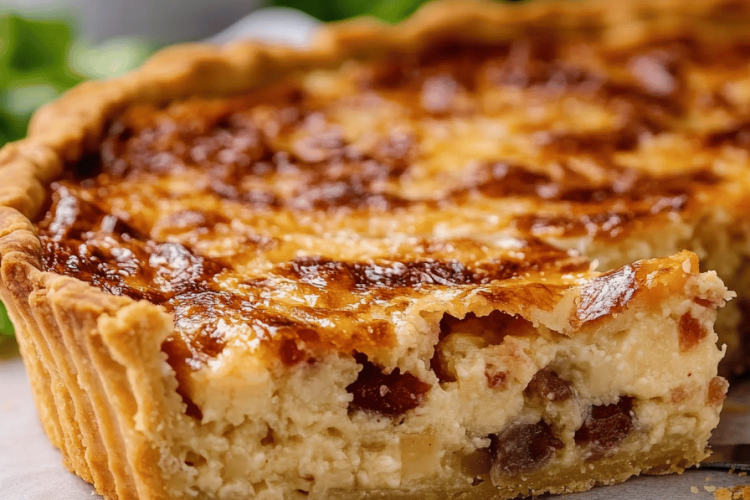Oh, Quiche Lorraine! Just saying the name makes me feel all warm and fuzzy inside. It’s one of those dishes that just screams comfort and elegance all at once, you know? For me, it’s tied to so many memories – lazy Sunday brunches with family, little picnics in the park with friends, and even those surprisingly busy weeknights when I needed something satisfying without a fuss. When I first started experimenting in the kitchen years ago, quiche felt a bit intimidating, like something you only got at fancy French bistros. But this Quiche Lorraine recipe? It’s truly a game-changer. It’s surprisingly simple to pull together, and the result is just… perfection. Imagine a flaky, golden crust hugging a rich, creamy custard filled with savory bacon and just a hint of nutmeg. It’s worlds away from some of the bland, rubbery versions I’ve encountered, and honestly, it’s a dish that has never failed to impress, whether it’s for a crowd or just for myself. If you’ve ever felt a bit daunted by making quiche from scratch, trust me, this is the one that will make you a believer. It’s that perfect balance of ease and deliciousness, and I’m so excited to share my tried-and-true method with you.
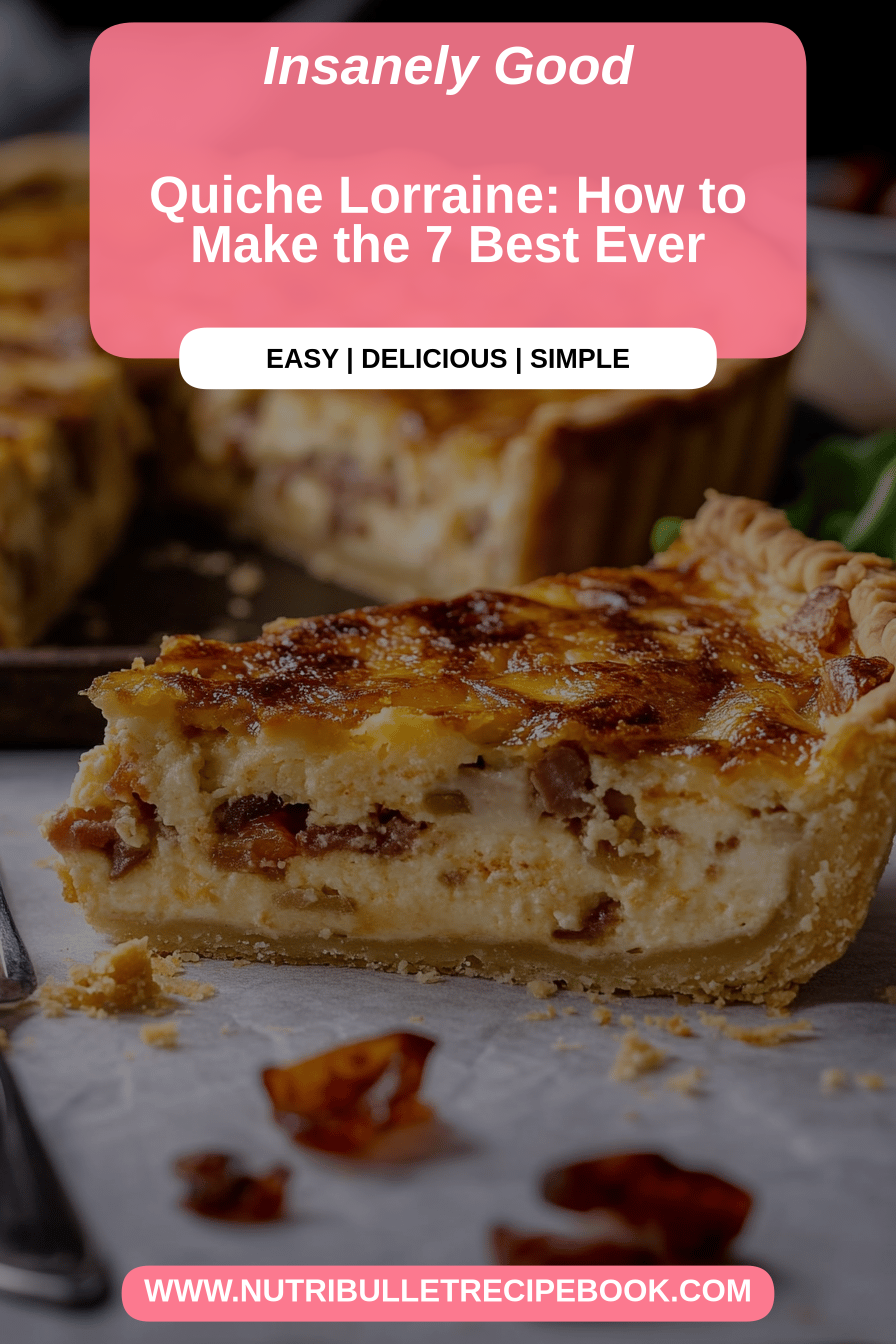
What is Quiche Lorraine?
So, what exactly is this magical thing called Quiche Lorraine? At its heart, it’s a savory tart originating from the Lorraine region of France. The classic French version is wonderfully simple: a rich egg and cream custard baked in a crisp pastry shell, studded with delicious smoked bacon. That’s it! No cheese in the traditional recipe, although many modern interpretations add Gruyère or Swiss cheese for an extra layer of flavor, which I’ll talk more about later. Think of it as a sophisticated, yet incredibly comforting, open-faced pie. It’s the kind of dish that feels special enough for a holiday gathering but is also wonderfully down-to-earth for a casual lunch. The beauty of Quiche Lorraine lies in its understated elegance and the way the simple, high-quality ingredients sing. The creamy custard, the salty bite of the bacon, and the buttery crust all come together in a symphony of textures and flavors. It’s a dish that truly celebrates the joy of good food made with love.
Why you’ll love this recipe?
There are so many reasons why this Quiche Lorraine recipe has become a staple in my kitchen, and I just know you’re going to fall in love with it too. First off, the flavor is absolutely out of this world. That combination of crispy, smoky bacon nestled in a velvety, eggy custard, all cradled in a golden, buttery crust is simply divine. Every bite is rich, savory, and utterly satisfying. It hits all the right notes! And the best part? It’s surprisingly easy to make. I know pastry can sometimes seem daunting, but I’ve got a few tricks up my sleeve that make it totally manageable, and the filling comes together in minutes. Seriously, this is a lifesaver on busy weeknights when you want something homemade and impressive without spending hours in the kitchen. It’s also incredibly cost-effective! Using simple ingredients like eggs, cream, and bacon, you can create a dish that tastes like it came from a gourmet bakery, all without breaking the bank. What I love most about this recipe is its incredible versatility. It’s perfect for breakfast, an elegant brunch centerpiece, a light lunch with a side salad, or even a delicious appetizer when cut into small squares. It truly adapts to any occasion. If you’re a fan of classic savory tarts or comforting egg dishes, this Quiche Lorraine is definitely going to become your new favorite, much like it has for me. It’s a true winner!
How do you make a quiche Lorraine?
Quick Overview
Making this Quiche Lorraine is a joy because it’s truly a straightforward process. You’ll start by preparing your pastry – whether you’re making it from scratch or using a good quality store-bought one, getting that golden, flaky base is key. Then, you’ll cook your bacon until it’s perfectly crispy. The magic really happens when you whisk together the creamy custard base with a touch of seasoning and gently fold in that delicious bacon. Pour it all into your prepared pie crust and bake until it’s set and beautifully golden. It’s a process that yields maximum flavor with minimum fuss, and the aroma that fills your kitchen as it bakes is simply irresistible. What makes my method special is focusing on getting that perfect custard texture – not too firm, not too jiggly – and ensuring every bite is packed with savory goodness. It’s a recipe that proves you don’t need to be a pastry chef to create something truly spectacular.
Ingredients
For the Main Batter:
2 cups all-purpose flour (plus extra for dusting)
1/2 teaspoon salt
1/2 cup (1 stick) unsalted butter, very cold and cut into cubes
4-6 tablespoons ice water
This is your classic pâte brisée, the foundation of any great quiche. For the best flaky crust, make sure your butter and water are ice-cold. This helps create those little pockets of steam during baking that make the pastry so tender and light. I always try to use a good quality butter for the best flavor. If you’re short on time, a good store-bought pie crust can absolutely do the trick; just make sure it’s a good quality one! The key is to handle the dough as little as possible to keep it tender.
For the Filling:
8 ounces thick-cut bacon, diced
1 1/2 cups heavy cream
3 large eggs
1/4 teaspoon freshly ground black pepper
Pinch of freshly grated nutmeg
1/4 teaspoon salt (adjust based on bacon’s saltiness)
The stars of the show here are, of course, the bacon and the creamy custard. I prefer thick-cut bacon because it gives you those lovely chewy, savory bits. You can absolutely add some grated Gruyère or Swiss cheese (about 1/2 cup) to the filling if you like a cheesier quiche – it’s not traditional, but it’s delicious! For the custard, using a mix of heavy cream and milk (or even half-and-half) can make it lighter, but I find that pure heavy cream gives it that luxuriously rich texture I adore. Freshly grated nutmeg is a must; it adds such a subtle, warm complexity that really elevates the whole dish. And always taste your bacon before adding extra salt to the custard!
For the Glaze:
1 tablespoon Dijon mustard
1 tablespoon honey or maple syrup
1 teaspoon water (optional, for thinning)
This glaze is my little secret weapon for taking this quiche from great to absolutely unforgettable. It adds a subtle tang and a hint of sweetness that perfectly balances the richness of the custard and the saltiness of the bacon. It sounds unusual, I know, but trust me on this one! The Dijon mustard provides a lovely sharpness, while the honey or maple syrup adds just a touch of sweetness. If it seems a bit too thick, a tiny splash of water can help thin it out to a brushable consistency. It’s so simple, but it makes a world of difference in the final flavor profile.
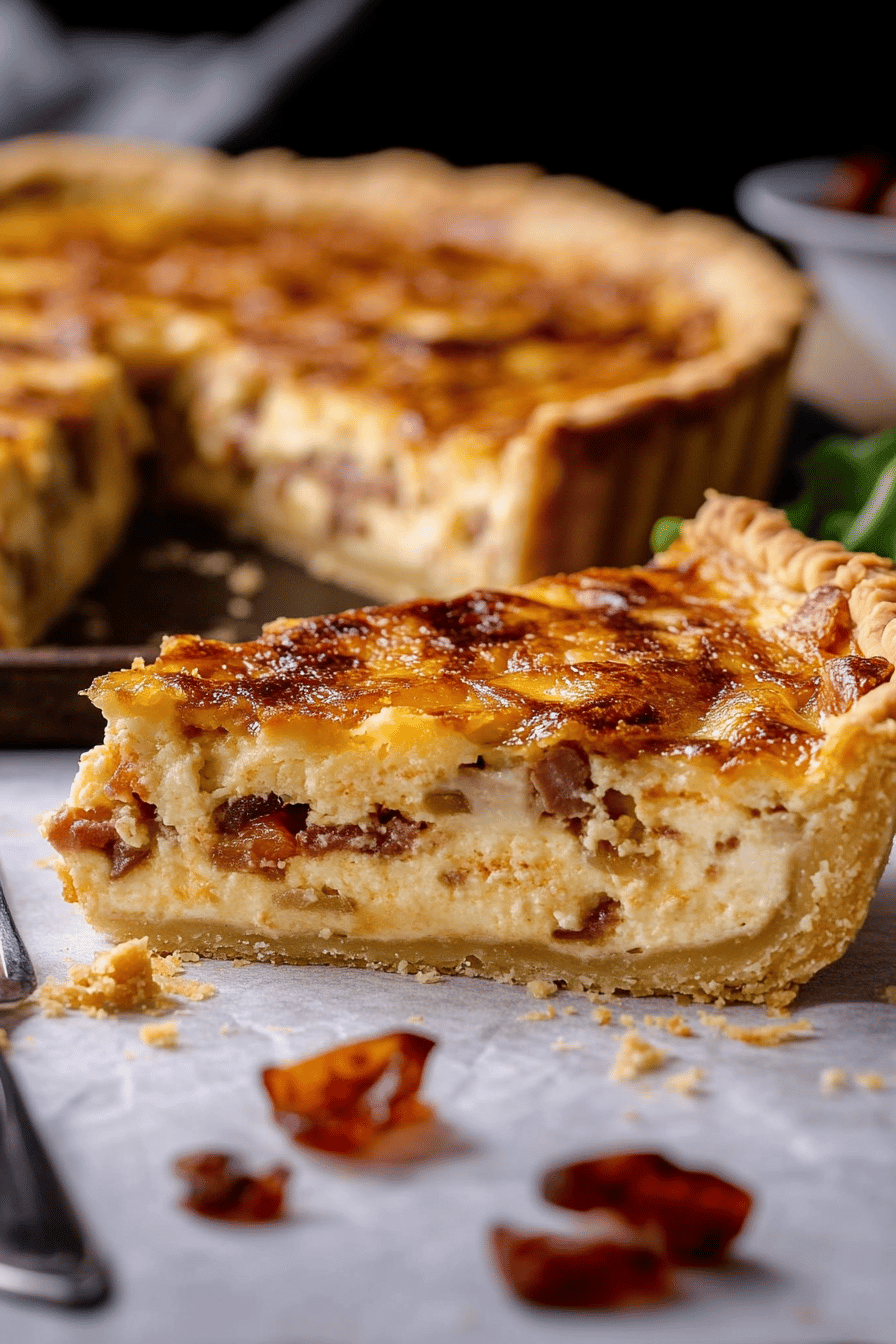
Step-by-Step Instructions
Step 1: Preheat & Prep Pan
First things first, let’s get that oven preheated to 400°F (200°C). This initial high heat helps get the pastry nice and golden right from the start. While the oven is heating up, grab your 9-inch pie plate. If you’re using a homemade crust, you’ll want to carefully press your prepared dough into the pie plate, making sure to crimp the edges decoratively – this is where you can get a little creative! Then, line the pastry shell with parchment paper and fill it with pie weights, dried beans, or even rice. This is called blind baking, and it’s crucial for preventing a soggy bottom. We’ll bake it for about 15 minutes like this.
Step 2: Mix Dry Ingredients
While your crust is blind baking, let’s get the pastry dough ready if you’re making it from scratch. In a large bowl, whisk together the all-purpose flour and salt. This ensures everything is evenly distributed before we add the wet ingredients. It’s a simple step, but it lays the groundwork for a tender, flaky crust. Don’t skip this! The texture is going to be light and airy, not dense or heavy.
Step 3: Mix Wet Ingredients
Now for the magic that makes the crust tender: the butter! Add your cold, cubed butter to the flour mixture. You can use a pastry blender, your fingertips, or even a food processor (pulse it gently!) to cut the butter into the flour until it resembles coarse crumbs with some pea-sized pieces of butter still visible. These little butter pockets are what create those lovely flaky layers. Then, gradually add the ice water, one tablespoon at a time, mixing just until the dough starts to come together. Don’t overmix – we want it just barely combined. Gather it into a ball, flatten it into a disc, wrap it in plastic wrap, and chill it in the refrigerator for at least 30 minutes. This resting period is super important for relaxing the gluten and making the dough easier to roll out.
Step 4: Combine
Once your pastry dough has chilled, it’s time to roll it out. On a lightly floured surface, roll the dough into a 12-inch circle. Gently transfer it to your 9-inch pie plate and press it into the bottom and up the sides. Trim any excess dough and crimp the edges as desired. You can prick the bottom of the crust a few times with a fork if you’re not blind baking. This step is all about getting that beautiful, sturdy foundation for our delicious filling. If the dough tears a bit, don’t worry! Pastry is forgiving, and you can always patch it up.
Step 5: Prepare Filling
Now, let’s get to the delicious part! In a skillet over medium heat, cook your diced bacon until it’s nice and crispy. Drain it well on paper towels to remove excess grease – nobody wants a greasy quiche! While the bacon is cooking, whisk together the heavy cream, eggs, black pepper, nutmeg, and salt in a medium bowl. Make sure everything is well combined but don’t over-whisk; we don’t want to incorporate too much air. Taste the custard and adjust the salt if needed, keeping in mind how salty your bacon is.
Step 6: Layer & Swirl
After blind baking the crust for 15 minutes, remove the parchment paper and weights. Carefully scatter the crispy bacon pieces evenly over the bottom of the par-baked crust. Now, gently pour the creamy egg mixture over the bacon. If you’re adding cheese, sprinkle it over the bacon before pouring the custard. The goal here is to distribute the filling evenly so you get that perfect ratio of crust to filling in every slice.
Step 7: Bake
Return the quiche to the oven, still at 400°F (200°C), and bake for another 15-20 minutes, or until the custard is just set and the top is beautifully golden brown. You can test for doneness by gently jiggling the pan – the edges should be set, but the center should still have a slight wobble. If the crust is browning too quickly, you can loosely tent the edges with foil. Be patient here; an underbaked quiche is sad, but an overbaked one can be rubbery. We want that perfect, creamy texture!
Step 8: Cool & Glaze
Once your quiche is baked to perfection, remove it from the oven and let it cool on a wire rack for at least 10-15 minutes before slicing. This resting time is crucial; it allows the custard to firm up completely, making it much easier to slice neatly. While the quiche is cooling, whisk together the Dijon mustard and honey (or maple syrup) in a small bowl. If it seems too thick to brush, add a teaspoon of water to thin it slightly. Gently brush this glaze over the top of the warm quiche. It adds that subtle sweet and tangy counterpoint that truly makes this quiche sing!
Step 9: Slice & Serve
Now for the best part – slicing and enjoying your masterpiece! Use a sharp knife to cut neat wedges. I love serving Quiche Lorraine warm, but it’s also delicious at room temperature. It’s truly a showstopper, and the aroma alone will have everyone asking for a slice. The contrast of the flaky crust, the creamy filling, and that hint of glaze is just divine. Prepare for compliments!
What to Serve It With
Quiche Lorraine is incredibly adaptable, making it perfect for so many occasions! For a classic breakfast, I love pairing a slice with a simple cup of black coffee. The richness of the quiche and the bold coffee are a match made in heaven. For a more leisurely brunch, I often serve it alongside a fresh green salad with a light vinaigrette. Think mixed greens, maybe some sliced cucumber and cherry tomatoes. A mimosa or a sparkling cider is a lovely beverage choice for brunch. If you’re feeling adventurous and want to serve it as a light lunch or even an appetizer, cut it into smaller squares and serve it with a dollop of crème fraîche or a sprinkle of chives. And for a truly cozy snack, sometimes I’ll just have a small slice on its own, perhaps with a glass of crisp white wine or even a light rosé. My family also loves it with a side of roasted potatoes or a simple Fruit Salad. It’s one of those dishes that always feels right, no matter how you serve it.
Top Tips for Perfecting Your Quiche Lorraine
I’ve made this Quiche Lorraine countless times, and along the way, I’ve picked up a few little tricks that I think make a big difference. For the bacon, always cook it until it’s truly crispy. Soggy bacon is a quiche killer! Letting it drain really well on paper towels is key. When it comes to the custard, don’t be tempted to over-whisk the eggs and cream. You want a smooth, velvety texture, not a frothy one. Overmixing can lead to a tougher custard. I learned this lesson the hard way after one too many rubbery quiches! If you’re using a homemade crust, remember to keep everything cold – the butter, the water, even your hands if it’s a warm day. This is what guarantees that beautiful flaky texture. If your dough feels sticky when you’re rolling it out, don’t be afraid to dust your surface and your rolling pin with a little extra flour, but go easy – too much flour can make the crust tough. For the glaze, the Dijon and honey combination is my favorite, but you could also experiment with a touch of smoked paprika mixed into the custard itself for an extra layer of smoky flavor, or even a sprinkle of fresh herbs like parsley or chives on top just before serving. When it comes to baking, ovens can be so different! Keep an eye on your quiche. If the crust starts to brown too quickly, you can loosely tent the edges with a piece of aluminum foil. The most important thing is to check for doneness – the center should still have a slight wobble when you gently nudge the pan. It will continue to set as it cools. Trust me on this one – that little bit of patience is so worth it for a perfectly cooked quiche!
Storing and Reheating Tips
One of the best things about this Quiche Lorraine is how well it stores and reheats. If you happen to have any leftovers (which is rare in my house!), you can leave it at room temperature for up to two hours. For longer storage, cover the quiche loosely with plastic wrap or foil and pop it into the refrigerator. It will stay delicious for about 3-4 days. I usually keep it in the pie plate, just make sure it’s well covered. If you want to freeze it, I recommend baking it first and letting it cool completely. Then, wrap the entire quiche tightly in plastic wrap, followed by a layer of aluminum foil. It can be stored in the freezer for up to 2-3 months. When you’re ready to reheat, the best method depends on how you stored it. For refrigerated quiche, you can reheat it gently in a moderate oven (around 300°F or 150°C) for about 10-15 minutes, or until warmed through. If reheating from frozen, it’s best to thaw it in the refrigerator overnight first. Then, reheat as you would a refrigerated portion. For slices, you can sometimes reheat them more quickly in a toaster oven or even a microwave, but be careful not to overheat, as the custard can become tough. The glaze is best applied just before serving when it’s warm, so if you’ve frozen the quiche, you might want to re-glaze it after reheating.
Frequently Asked Questions
Final Thoughts
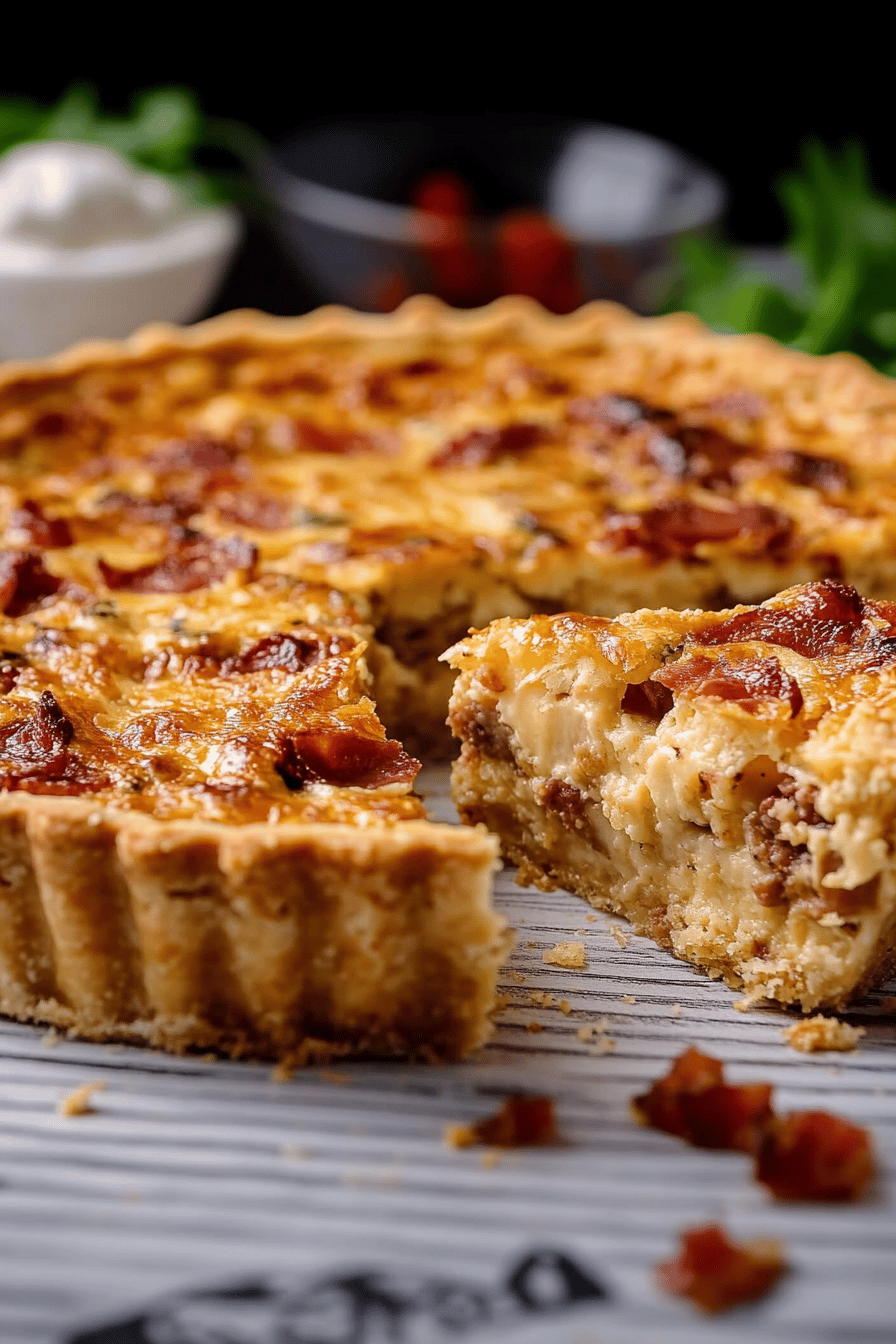
And there you have it – my absolute favorite Quiche Lorraine recipe! I truly hope you feel inspired to give this a try. It’s more than just a recipe; it’s a feeling of warmth, comfort, and shared joy. The way the crispy bacon, creamy custard, and flaky crust come together is simply magical, and I can’t wait for you to experience it. Whether you’re making it for a special occasion or just a weeknight treat, this Quiche Lorraine is guaranteed to be a hit. If you love classic savory bakes, you might also enjoy my recipe for [Link to another relevant recipe, e.g., Savory Mushroom Tart] or my easy [Link to another relevant recipe, e.g., Crustless Spinach Quiche]. They’re all fantastic in their own way! I’d love to hear how your Quiche Lorraine turns out, so please leave a comment below and tell me all about your experience, or even share your own favorite variations. Happy baking, and enjoy every delicious bite!
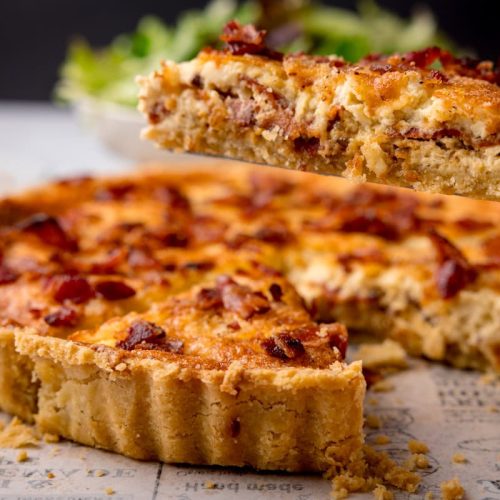
Quiche Lorraine Recipe
Ingredients
Crust
- 2.5 cups all-purpose flour
- 1 teaspoon salt
- 0.75 cup cold unsalted butter, cubed
- 0.5 cup ice water
Filling
- 0.5 pound bacon, chopped
- 1 medium onion, finely chopped
- 4 large eggs
- 2 cups heavy cream
- 0.5 teaspoon salt
- 0.25 teaspoon black pepper
- 0.125 teaspoon nutmeg, freshly grated
- 1 cup Gruyere cheese, grated
Instructions
Preparation Steps
- For the crust: In a large bowl, whisk together flour and salt. Cut in the cold butter with a pastry blender or your fingertips until the mixture resembles coarse crumbs with some pea-sized pieces. Gradually add ice water, 1 tablespoon at a time, mixing until the dough just comes together. Do not overmix.
- Gather the dough into a ball, flatten into a disc, wrap in plastic wrap, and refrigerate for at least 30 minutes.
- Preheat oven to 375°F (190°C).
- On a lightly floured surface, roll out the dough to a 12-inch circle. Carefully transfer the dough to a 9-inch pie plate. Trim and crimp the edges. Prick the bottom of the crust with a fork.
- Line the crust with parchment paper and fill with pie weights or dried beans. Blind bake for 15 minutes. Remove the parchment paper and weights, and bake for another 5-7 minutes, or until lightly golden.
- While the crust is baking, cook the bacon in a large skillet over medium heat until crisp. Remove bacon with a slotted spoon and drain on paper towels. Reserve 1 tablespoon of bacon drippings in the skillet. Add chopped onion to the skillet and cook until softened, about 5 minutes.
- In a medium bowl, whisk together eggs, heavy cream, salt, pepper, and nutmeg.
- Scatter the cooked bacon, sautéed onions, and grated Gruyere cheese evenly over the bottom of the pre-baked pie crust.
- Pour the egg and cream mixture over the bacon, onions, and cheese.
- Bake for 35-45 minutes, or until the center is set and the top is golden brown. If the crust edges start to brown too quickly, cover them with foil.
- Let the quiche cool for at least 10-15 minutes before slicing and serving.

